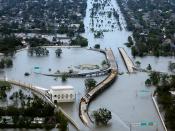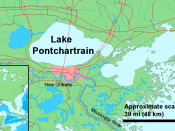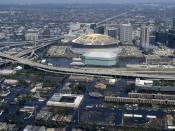One of the most destructive hurricanes to ever hit the United States, slammed into the city of New Orleans, on August 29, 2005. Katrina's deadly storm surge damaged the city's levees, the only thing that protected the city from flooding. The aftermath of Hurricane Katrina, is unimaginable, with lives, jobs and homes lost to thousands of Americans. The problem that needs to be faced, is how to deal with this catastrophic natural disaster.New Orleans should not be rebuilt due to its ongoing health concerns, cost to the economy and its geological location. The first problem that needs to be looked at before anyone can even go back into New Orleans, is the contamination found in the flooded waters.
New Orleans was a disaster waiting to happen. Hurricane and flood preparation in the city of New Orleans has always been an issue, even before Katrina struck. Its location is a huge threat, having to rely on levees, being below sea level, and having been built on a delta marsh, makes it hurricane prone.
The first problem is how much the city has to rely on levees. Levees are barriers constructed to contain the flow of water. The six levees in New Orleans, were only meant to withstand a Category 3. Because New Orleans is surround by water (Mississippi River, Lake Pontchartrain and the Gulf Coast), it is vital that the levees function properly. Secondly, New Orleans is primarily situated below sea level. In fact, nearly eighty percent of New Orleans lies below sea level, more than eight feet below in places, so the water pours in. Lastly, New Orleans is situated primarily on top of a marsh. The city acts like a huge bowl, surrounded by water. The marsh is slowly being pulled underwater. The delta soils compact...


